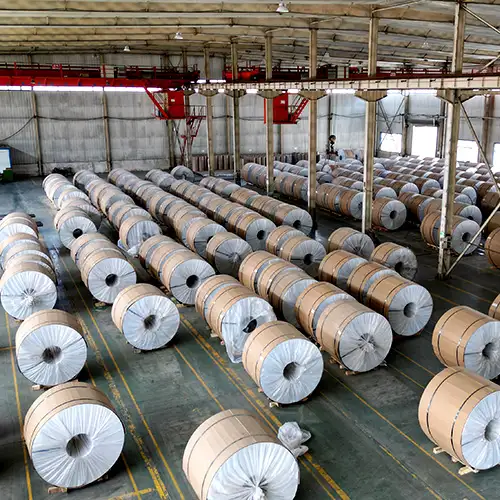The secret of the production process of roller-coated aluminum coils
Release time:
2025-05-14
Source:
In the field of modern industry and construction, the choice of materials directly affects the quality, beauty and durability of the project. As a new material with many advantages, roller-coated aluminum coil is rapidly emerging in various fields and has become the first choice of many designers, engineers and project owners.
(I) Raw material selection
When producing roller-coated aluminum coils, the selection of aluminum alloy materials is crucial. Common aluminum alloy materials include 1060, 3003, 5052, etc., each of which has unique characteristics. 1060 pure aluminum material has high purity, and its aluminum content is usually above 99.6%, which makes it have excellent conductivity and good processing performance. It is easy to perform various forming operations, such as bending and stamping. Therefore, it is widely used in the manufacturing of electronic equipment parts with high conductivity requirements and complex processing technology. 3003 aluminum alloy is pure aluminum with manganese added. Its strength is higher than 1060 pure aluminum, while maintaining good corrosion resistance and processing performance. In the field of architectural decoration, such as the production of aluminum curtain walls and ceilings, 3003 aluminum alloy roller-coated aluminum coils can meet the dual needs of strength and beauty. Magnesium is added to 5052 aluminum alloy. It has medium strength, good corrosion resistance, weldability and cold processing performance. In the fields of automobile manufacturing and aerospace, 5052 aluminum alloy roll-coated aluminum coils are used to manufacture some parts with high requirements for comprehensive material performance, such as automobile body covers and aircraft wing skins. High-quality raw materials are the cornerstone of ensuring the performance of roll-coated aluminum coils. Only by choosing the right aluminum alloy material can we provide a solid guarantee for subsequent processing and product performance.
(II) Detailed explanation of roll-coating process
The roll-coating process is the core link that gives roll-coated aluminum coils rich colors and excellent performance, mainly including primer roll-coating and topcoat roll-coating. Primer roll-coating is to apply a layer of primer on the surface of the pretreated aluminum coil. The main function of the primer is to enhance the adhesion between the coating and the aluminum coil substrate, while providing good support and protection for the topcoat. For example, epoxy primer has excellent adhesion and chemical corrosion resistance, can firmly adhere to the surface of aluminum coils, form a solid barrier, effectively prevent the aluminum coil substrate from being corroded, and lay a solid foundation for the coating of topcoat. Topcoat roller coating is to apply topcoats of various colors and performances on the primer according to customer needs and design requirements. The topcoat not only determines the appearance color and decorative effect of the roller-coated aluminum coil, but also further improves the weather resistance, wear resistance and other properties of the product. For example, fluorocarbon topcoat has excellent weather resistance and corrosion resistance, can maintain bright colors and smooth surface for a long time in harsh natural environments, and is widely used in the field of outdoor architectural decoration. In the roller coating process, through precise roller coating equipment and strictly controlled process parameters, it can ensure that the coating is evenly coated on the surface of the aluminum coil, realize accurate control and diversification of colors, and meet the personalized needs of different customers for color and appearance.
If you have any needs or questions about roller-coated aluminum coils, please feel free to contact us. We look forward to becoming your most reliable partner and working together to create a brilliant future.
Related News
Shining 2025 China International Aluminum Industry Exhibition
From July 9 to 11, 2025, the highly anticipated 20th China International Aluminum Industry Exhibition will be held in Shanghai New International Expo Center.
The aluminum wire drawing process is a commonly used metal processing process in which aluminum is stretched and extruded to form the desired shape and size.
Aluminum plate types Aluminum plate usage guide
The 1 series aluminum plate model is the key raw material for manufacturing the bottom reflector of the heat pipe of solar water heater.
3 series aluminum plate material and model
The 1 series aluminum plate model is the key raw material for manufacturing the bottom reflector of the heat pipe of solar water heater.
1 series aluminum plate related knowledge
The 1 series aluminum plate model is the key raw material for manufacturing the bottom reflector of the heat pipe of solar water heater.
1mm aluminum plate The use of 1mm aluminum coil
1mm aluminum plate and 1mm aluminum coil have a wide range of applications in many fields because of their moderate thickness



